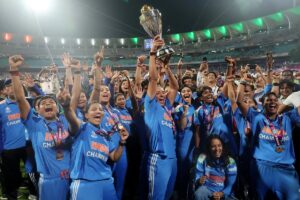
Ashok Namboodiri
When India Women lifted the ICC World Cup at DY Patil Stadium, it wasn’t just a sporting milestone, it was a brand moment. The kind of inflection point that marketers, broadcasters, and investors wait decades for. For years, women’s cricket in India was a promise waiting for a platform. Now it has a product, a proposition, and most importantly, a reason to believe. This victory turns women’s cricket from a sub-brand to a standalone franchise.
In 1983, India discovered the power of cricket as a cultural asset. In 2025, India has discovered it as a diversified business portfolio. The win at DY Patil has created a moment every brand strategist dreams of — when passion converts to participation, and participation to purchase. Women’s cricket has crossed the credibility chasm. What was once “good optics” is now good business.
Broadcasters now have a new growth engine. The Women’s Premier League’s (WPL) steady ratings curve has already shown that appointment viewing is not gendered. The World Cup win will turbocharge that, ensuring dedicated windows, higher CPMs, and fresh advertising inventory during a traditionally lean calendar phase. Digital platforms, in particular, see women’s sport as a content efficiency play — cheaper rights, deeper engagement, and better advertiser alignment with progressive audiences. Expect WPL rights in the next cycle to appreciate by 70–100%, and streaming platforms to bid aggressively to own the next phase of women’s cricket storytelling.
Marketers are realigning their playbooks. Until now, women athletes were often part of “ensemble campaigns” — the supportive faces in gender-equality narratives. That will change. Post the World Cup, one can safely expect category exclusivity deals, especially in FMCG, fintech, and fashion. Anchor brand partnerships with Smriti Mandhana, Harmanpreet Kaur, and Jemimah Rodrigues will be the norm and we willl witness hybrid influencer models that integrate cricket into lifestyle storytelling. The demographic dividend is clear: a younger, urban, digital-first audience that values authenticity and empowerment over legacy and hierarchy. For advertisers, this is not a niche; it’s the new mainstream.
The World Cup win cements the WPL as India’s next billion-dollar sports property. Franchise valuations are expected to double within three years and media rights could surpass Rs 1,500 crore by the 2028 cycle. Cross-league synergies between IPL, WPL, and domestic cricket academies will spawn new verticals: merchandising, fantasy gaming, grassroots scouting, and OTT documentaries. Much like how the IPL turned broadcast time into a financial calendar, the WPL will turn women’s cricket into a content economy. By 2030, women’s cricket could contribute nearly 25% of Indian cricket’s commercial ecosystem, up from less than 5% in 2022.
For India Inc., women’s cricket is not just a media property, it’s a brand with purpose.
It ticks every modern KPI — authenticity, emotion, equality, sustainability, and scale.
It is the perfect confluence of culture and commerce, the sweet spot where corporate storytelling meets national identity.
In 1983, India discovered belief. In 2025, India discovered balance. Women’s cricket no longer rides on the men’s game. It complements, competes, and sometimes even outperforms it. For broadcasters, brands, and investors, this isn’t the future of sport. It’s the fastest-growing vertical of Indian entertainment. The game has changed and this time, it’s hers to own.
Follow Revsportz for latest sports news
